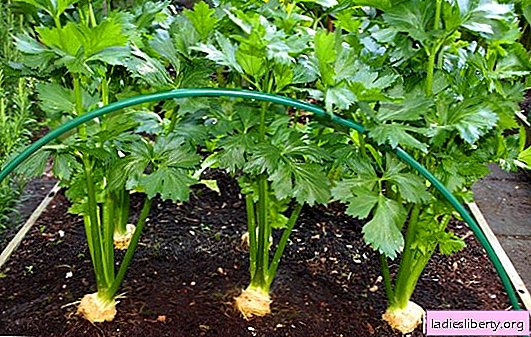
To get a big crop of juicy and large root crops of celery and provide your family with healthy vitamin salads for the whole winter - do you dream about this? You have not tried to grow root celery and do not know how to care for it, or have already tried, but as a result you got small roots of poor quality? Every gardener can grow a decent crop of this root crop, you only need to know a few rules and secrets of caring for this crop.
The most important thing when growing this vegetable is the duration of its growing season, this must be taken into account when buying seeds. This culture grows for a very long time; most varieties develop only in 120-200 days after sowing seeds. This suggests that in the middle lane it is best to acquire early ripe varieties and grow them through seedlings. Using the seedlingless method, suitable only for the southern regions, the rest of the gardeners will need to make efforts to obtain high-quality seedlings.
Seed preparation
Celery seeds (like parsley and carrots) are very demanding. They may not germinate if they have been stored for a long time, for this reason this crop needs to be sown only with fresh seeds, it’s good that you can use your own. In addition, they are saturated with essential oils that protect them from external negative influences, but at the same time they significantly complicate germination. For quick and friendly seedlings, seeds must be soaked in advance for 48 hours and then germinate them. When soaking, it is important every 6 hours to change the water in which the seeds are soaked and when germinating, constantly moisten the tissue in the saucer. After the first cloves appear, the time comes to sow them for seedlings. This is done from February 5 to March 15.
Growing seedlings
It is best to grow celery seedlings in a special soil mixture, it consists of 1 share of mullein, 1 share of sod land, 2 shares of overripe humus and 6 shares of high peat. You can make a mixture of vermicompost and sand.
Sowing celery is carried out in small boxes according to the 2x2 cm scheme, this operation is conveniently carried out using a toothpick or matchstick - it makes a small depression in the ground, after which the seeds are laid. From above, the crops are covered with soil by 5 mm, covered with a film and placed in a dark and warm place.

The soil must be regularly sprayed with water as it dries. After about 7 days, seedlings will be noticed. During this period, a box with seedlings is transferred to a cool and bright windowsill. The most suitable temperature during this period is +16 degrees. At first, seedlings will look like fragile and thin blades of grass, for this reason celery seedlings should not be watered like other crops, but only sprayed, and if the weather is suitable, they should be taken out onto the balcony. The temperature should not be lower than 8 degrees Celsius, low temperatures for celery seedlings are harmful, you can get instead of a juicy root crop, a hard and shallow root with a flowering arrow at the top. After 2 real leaves are formed at the seedlings, they are dived, each of them transplanted into its own pot, breaking off 1/3 of the main root during transplantation. When transplanting, the seedlings are buried to the cotyledon leaves, only in no case should you sprinkle the growth point.
Before planting the plants in the garden, it is advisable to feed them two times, with a mixture of mineral and organic fertilizers. Experts recommend fertilizing with solutions of complex fertilizers, sodium humate, a solution of bird droppings, and spray the seedlings with a weak solution of potassium permanganate.
Soil preparation
It is necessary to plan in advance a plot in the garden where root celery will grow, to get the maximum yield you need a sunny place and fertile soil rich in humus. It is good to grow it on light sandy loamy fertile soils. In autumn, at the place of the planned beds, it is necessary to make as much as possible well-rotted manure or quality compost. For this purpose, poor rocky, sandy, marshy and acidic areas are practically unsuitable. Before growing celery, the acidity of the soil must be reduced by liming. It is best to plant root celery after crops such as cabbage, tomatoes and cucumbers.
Planting seedlings in the ground
It is not worth rushing to plant celery; it is better to wait until warm weather sets in, until about May 15th. You can not densely plant seedlings (it is necessary to leave a space between seedlings of 30 cm) and it is strictly forbidden to sprinkle a growth point. Having fulfilled such requirements, the gardener will be able to get large and unbranched root crops. After planting, plants need to be watered well. It is advisable to plant seedlings in the morning in cloudy weather. If there is a risk of recurring night frosts, it is advisable to protect the seedlings with cut plastic bottles.
The secrets of growing celery root
There are basic methods for caring for root celery, without which it is almost impossible to get a decent crop of root crops.
Watering. This culture loves moisture; it is impossible to allow the soil to dry out. Throughout the growing season, until the harvest, the soil in the area with celery must be constantly kept moist. Water the plants directly under the root.
Top dressing. Plants need to be fed 4 times during the season. The first fertilizing promotes the rooting of seedlings and stimulate their growth, the subsequent increase the size of the root crop. After 7 days have passed, the plants are fertilized with herbal infusion, after 2 weeks - with infusion of chicken manure or mullein. In mid-summer, celery is well fed with a superphosphate solution, after the head of the root crop begins to form - a solution of boric acid.
Hilling. It is not worth doing this with root celery, just do it harm, experienced gardeners advise them on the contrary - after the root crop begins to become thicker, it is necessary to dig soil from it so that additional roots do not form.
Loosening. This operation will bring celery only benefits, do not miss the moment when the plants have not yet grown, regularly during this period, loosen the ground between them.
Removal of lateral roots and excess leaves. By scooping up the soil from celery roots, you will find lateral roots grown on it from the round root. They will not bring benefits, they will only take away strength, spoil the appearance of the root, and interfere with gaining mass. For this reason, they are advised to cut with a knife. The leaves of any type of celery can be used in cooking, but you should not touch them during active growth, the time for their use will come in early September, after the root crop begins to grow rapidly, during this period the extreme leaves are removed, leaving only growing vertically.

Harvesting. Harvesting celery roots is one of the main joys of the gardener in the autumn, they are harvested late before the onset of frost on October 1-15. Harvest is not afraid of the first frosts, root crops can endure frost up to 3 degrees without damage.











